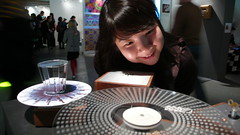PEAL Proposal
PEAL | Info Pack | Press | Acknowledgements | Research | Development
Submitted to Expo – 29th May 2009
The sound of ringing church bells weaves an ever present and evocative ‘sound fabric’ across the city – and indeed the country. We believe that the sonic distinctiveness, physical mechanics, permutational mathematics, historical resonance, community focus and sheer emotive quality of bell-ringing make it an ideal subject for artistic exploration and interpretation – and perfect for a sound art festival that aims “to step out from traditional venues and into spaces that lie at the heart of the community – inspiring practitioners and the public to reconsider their environments.”
We propose an interactive sound installation work for The Leeds Arena which models the operation of a traditional church bell tower – replacing the bell ropes by an optical sensing system where breaking beams of laser light triggers the ringing process of individual bells. The installation will be programmed to reproduce – through a simple pushbutton interface – the distinct ringing sounds and characteristics of five churches spread across the Leeds Metropolitan District. The system will attempt to model the physical characteristics and mechanics of actual bells, in order to provide a faithful experience of some of the timings, techniques and skills required to ring traditional bell changes.
The installation will be modelled on the layout of a traditional bell tower – hung for full-circle ringing – with the arrangement carefully demarcated on the floor. A thin cloud of incense-like smoke will illuminate a ring of vertical beams of laser light, each one positioned in place of a bell rope. When a beam is interrupted by a player’s hand, the installation models the ringing of the appropriate bell through a multi-speaker sound system, as if its corresponding rope had been pulled. The beam illumination is turned off to represent the rope rising, and comes back on – as the imaginary rope descends – so that the ringing cycle can continue.
Additionally, we intend to engage with and capture the essential qualities of the environs and practices of bell-ringing in Leeds by documenting the church buildings, their peals of bells and their bell-ringing activities through audio field recordings, HD video and high quality photography. These recordings will be used to create five 10 minute, visually stunning films – one for each church and each of the five screens in The Leeds Arena; audio recordings of the actual peals of bells for our virtual bell tower; and expressive visual imagery – such as light through stained glass windows – for additional slide projection within The Leeds Arena to recreate the ambience and atmosphere of a traditional church bell tower.
The installation will operate in various modes. As a “timepiece” it will mark the hours and quarters of the day with distinctive ‘sonic events’ – playing some of the better known ‘named’ changes. In “self-play” mode it will play through (and display on-screen) a series of permutations or ‘changes’ over periods which might last as long as several hours. As an “interactive” it will show on-screen tutorial materials and a variety of bell ringing patterns which visitors will be encouraged to attempt to reproduce by ‘playing’ the laser beams themselves. As an “instrument” it could be used for performance by members of the participating bell-ringing groups.
Appendix
“Bell-ringing is the most English of sounds. While many nations hang bells in the towers of their churches and religious foundations to call the faithful to prayer, it was in England that the ringing of bells “full circle” with rope and wheel was invented and then elevated to an art form. Only in these islands – and a handful of other places in the English-speaking world where bell-ringing was exported by empire – can you hear practised the art of “change-ringing”, the ringing of bells in fiendishly complex mathematical patterns in which no sequence of changes is repeated.
For centuries they have marked the significant moments in the story of our nation and the lives of its inhabitants. They have celebrated coronations and marked the deaths of monarchs; they have sounded the thrilling note of victory and warned of danger from flood, storm or foreign invasion. Their ringing at the conclusion of a marriage service is the most joyous and public of statements announcing the union between two newly-weds, while that slow, solemn cadence drifting from the church tower, each long note followed by its half-muffled echo, instinctively commands in the listener respect for and reflection upon a life that has ended.”
